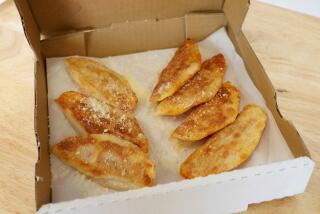East Asian Cultures
- Share via
Europe happily cultures cheeses (and to a lesser degree sausages) with mold, but otherwise it’s rather opposed to seeing furry little spots grow on its food. East Asia is not so squeamish.
Take sufu, sometimes called Chinese cheese, which is tofu inoculated with the prettily named Actinomucor elegans and fermented three to seven days, then aged in a mixture of brine and wine 40 to 60 days. Another product cultured with A. elegans is mentauza, which is the solids from soybean milk pressed into cakes and fermented 10 to 15 days. Chifan is basically a sort of sufu fermented with a different mold for a week and then aged in wine for a year.
Fermented minchin is wheat gluten rotted with a whole bunch of molds (Paecilomyces, Aspergillus, Cladosporum, Fusarium, Syncephalostrum, Penicillium and Triochethecium) for a couple of weeks, then salted and aged two weeks longer and finally cut into strips and used as a condiment.
Ang-khak, also known as beni-koji or Chinese red rice, is used as a food coloring for fish, cheese and wine in China and the Philippines. It’s made by allowing Monascus purpureus, a pigment-producing fungus, to grow on rice kernels for three months. On Taiwan, it colors a reddish local rice drink named anchu.
The Indonesian product ontjom has its own special mold, Neurospora sitophila. It comes in cakes like the soy product tempeh, but it’s made from the “press cake” left over after oil is extracted from peanuts. Fried ontjom is said to taste like mincemeat. To serve, sprinkle with sugar and salt and cover with ginger sauce.


